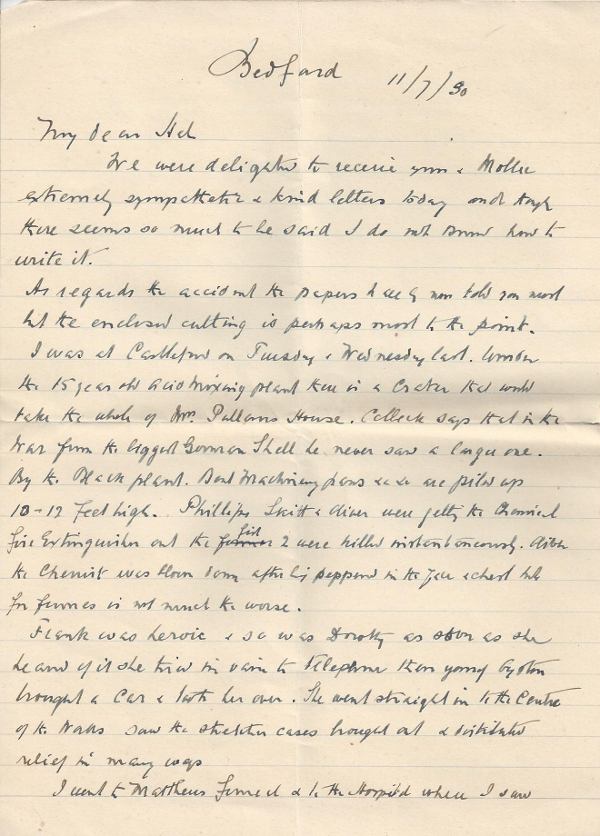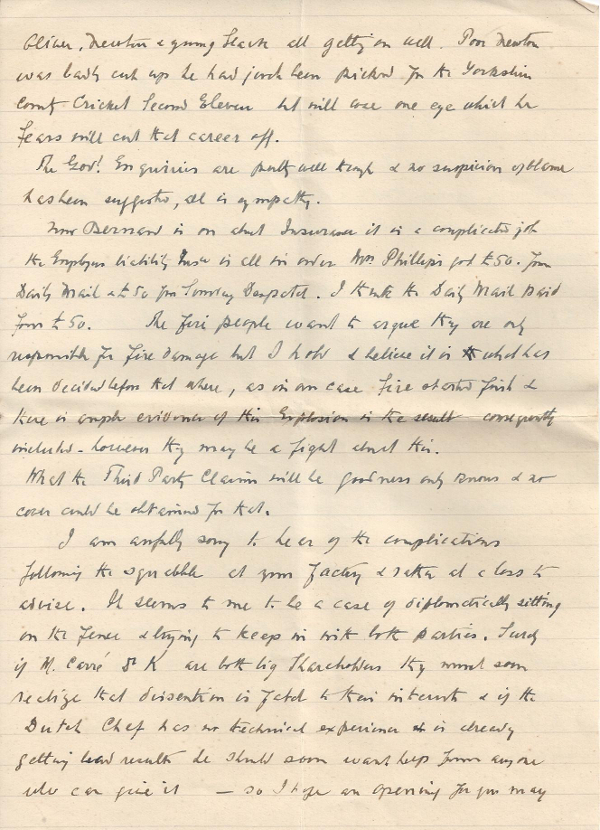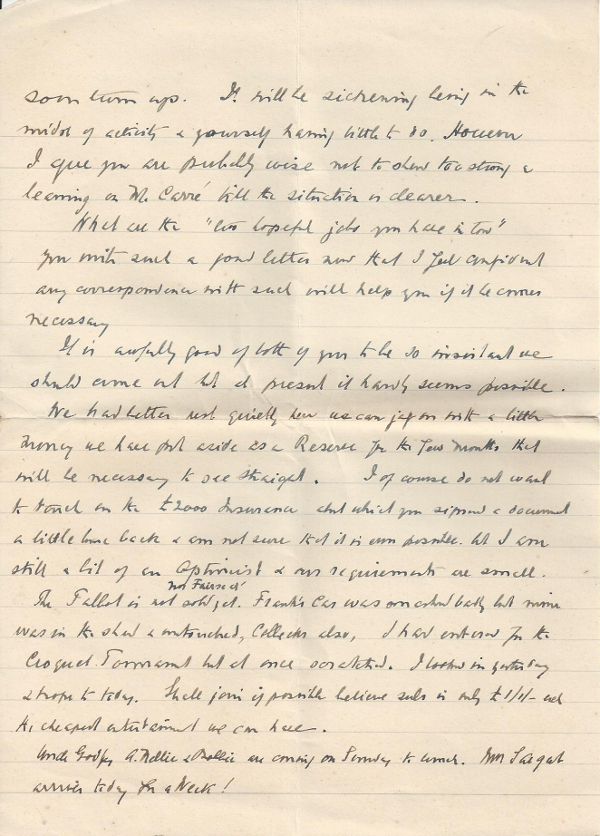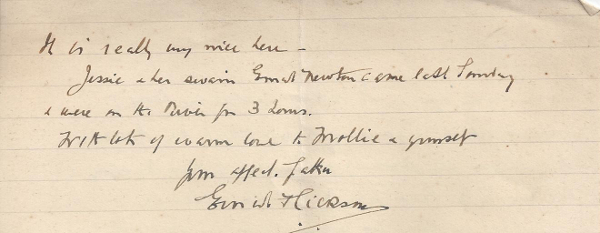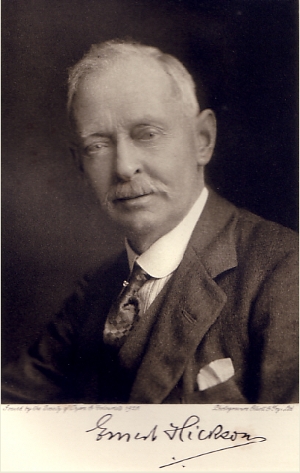
A THIN, wiry frame, ever on the alert, ever wakeful, ever watchful, and with all the smartness of the Londoner added to the practical hardheadedness of the Yorkshireman, and within the whole a warm and sympathetic heart - that was Ernest Hickson.
Born at Highgate, London, on the 3rd October, 1857, where now stands the main entrance to Waterlow Park, nothing gave Ernest greater amusement than the manner in which unwary London journals sometimes alluded to him as "a Yorkshireman", obviously unaware of the fact that he was born and bred so near the heart of Cockaigne.
He was educated first at a private school in Northampton (where his father was a partner in the boots and shoe making firm of William Hickson and Sons), and then at Hanover, where he spent over three years, attending first the Realschule - the public high school corresponding to our "modern side" - and then the Polytechnicum, where he studied chemistry (under Professors Heeren and Kraut), and physics.
Leaving Hanover in 1875 he went to Paris to acquire French and started his business career in the office of a firm of merchants who exported articles from Paris to England and elsewhere.
He returned to London after 18 months, and after a short time spent partly at his father's boot and shoe manufacturing warehouse in Smithfield, London, and partly in a tea-broker's office, he began his long connection with the chemical industry by joining the famous colour manufacturing firm of Brooke, Simpson and Spiller as foreign correspondent, the first firm to make aniline dyes on a large scale in England, and at that time occupying a unique position in that industry throughout the world.
In this capacity he made two long trips through Europe to nearly all the countries in which the textile industry at that time flourished. Ernest's interest in chemistry induced him to attempt to obtain technical experience of dyeing and dyestuffs. No facilities were available at the firm's offices in Old Broad Street, and the factory at Hackney Wick was then not very accessible. So under very trying conditions he managed to carry out some work in the office, where gas (but not water) was available. He was able to dye a full range of the firm's colours on wool, silk, and cotton in the intervals of his duty as foreign correspondent. His linguistic accomplishments led to his accompanying a member of the firm through Europe, on a tour of their agencies. Later he travelled in the industrial districts of Western and Central Europe. He commenced as a travelling salesman for the firm in 1882. The following year the firm opened a branch office in Bradford; Ernest took charge, and lived there for the rest of his life.
Ernest married Mary Grandage on the 9th August 1889 and during the next four years they had three children, their son, Bernard being born on the 28th May 1890.
The firm of Brooke, Simpson and Spiller was converted into a limited company in 1885 and Ernest was given the first vacancy on the board of directors. A little later, about the year 1890, the company was on the down grade. They passed the dividend for several years running and in 1893 Ernest persuaded the Board to agree to certain modifications, notably to take in some outside shareholders for consultation. During Ernest's absence for a few days this resolution was cancelled and in consequence he severed his connection with the company and commenced business in Bradford as a dealer in dyes and dyewares.
Ernest was associated with Monsieur R. Vidal, the pioneer in the evolution of sulphur black, when M. Vidal came to London in 1890 to form the Vidal Fixed Aniline Dyes, Ltd. Ernest was keenly interested in all developments in that very important series of cotton blacks. From 1898 he acted as agent to the Vidal Fixed Aniline Syndicate. Some years later, he assisted in the formation of Rexoll, Ltd. which manufactured sulphur blacks, and became managing director of the company.
Our grandfather's marriage
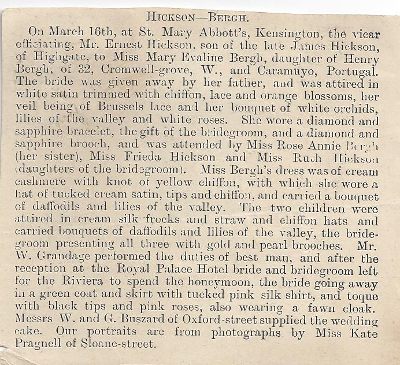
This was his second marriage, his first wife having died.
Previous to the great war he had factories first at Shipley for the manufacture of brands known as Rexoll but unfortunately these works burnt down twice. He moved the sulphur black manufactory to Wakefield where he had taken over the copperas works, a 100 years' old Cheld Lane Calico Works and was making a special 100s Tw. nitrate of iron.
In 1914, at the request of the War Office, the manufacture of TNT was undertaken, and as the Wakefield works were not large enough, Ernest formed the firm of Hickson and Partners Ltd (H&P), and a large works was erected at Castleford. Of this company he became managing director and subsequently chairman.
It was subsequently (1920) converted into a factory for the rectification of benzol and for the manufacture of sulphuric acid and a large number of amido, nitro and chloro-amido dyestuff intermediates. In addition to these, sulphur blacks and magentas were products for which the firm was noted. The company, and its successor, Hickson & Welch Ltd, carried on the manufacture of dyes and intermediates.
Ernest was closely connected with the Society of Dyers and Colourists ever since its birth. He was present at the inaugural meeting in 1884, was a member of the first council, and served continuously on that body for 45 years. He was appointed first chairman of the publication committee, and retained office with one short interval for 40 years. He was president during the period 1925-26 and it was due to his initiative that the Society undertook the monumental Colour Index. When it was published, he was presented with a special copy (now in my possession - APH) and an illuminated acknowledgment of the fact that the publication of the work was due to his original conception and an enthusiasm which overcame all difficulties. For distinguished services to the Society he was in 1927 awarded the Gold Medal and was made a life member. He was chairman of the Dyes and Explosives Section of the Association of British Chemical Manufacturers and the Board of Trade appointed him a member of the Dyestuffs Advisory Committee, under the Dyestuffs Import Regulation Act.
During the war, Ernest assisted in the formation of the Yorkshire Chemical Manufacturers' Association, which was later merged in the Chemical Employers' Federation. He acted as honorary chairman of the Yorkshire branch of the latter, and as vice-chairman of the national executive.
All through his life Ernest was a keen sportsman and took a particularly active part in the organisation of the National Cyclist Union of which he was a vice-president - in that connection he was more particularly noted for the active part he took in the Harrogate Camp, an event that brought cyclists from all parts of the Queen of Watering places every August Bank Holiday for some 20 years up to 1902. He was president in 1901.
His introduction to the wheel, however, occurred in neither London nor Yorkshire, but in the home of "the wee, wee German lairdie", Hanover, where the family had removed for a time during the rebuilding of the parental roof in 1869. There, on a fearful and awful monstrosity (as we should judge it in these days), a convertible bi-tri boneshaker, he was initiated in the mysteries of the wheel, and later, when at school at Northampton, he had at least one "thrilling experience" of the boneshaker, which had disastrous consequences to himself and a schoolfellow cyclist. Again in Hanover, in 1872-5, for the completion of his education, he continued his wheeling; but it was in 1877, after he had returned to London, that he fairly succumbed to the fever of the cycle. There, in the neighbourhood of Wrotham, on a Singer, with trailing brake - and a good brake, too, as brakes went then - he fairly mastered the peculiarities of the G.0.0, and following on that with a Coventry Machinists' "Club", he stuck to the high machine long after most others had forsaken the old love for the new.
In 1883 he removed from London to Bradford, and soon after began his work for his cycling brethren. Joining the old Bradford C.C. in 1884, was elected the honorary secretary, and in 1885 the Harrogate Camp Committee placed him in a similar position to the great meet of the year. There he worked through a code of rules of which he, deservedly, spoke with pride, and in 1886 and again in 1888 he was re-elected Honorary Secretary. His occupancy of the post was marked by an infusion of new life into the meet, and it might almost be said that "Harrogate" owed more to Ernest Hickson than any other single man. That he was proud of the connection all campers knew, for he was seen, every year, with one more "camp button" displayed at the tail-end of an unbroken series.
His connection with the N.C.0 was very close for many years, ever since 1888, when, as a representative of the Bradford C.C. on the West Riding centre, he noticed Mr. F.W. Brock's skeleton scheme for the liberation of the provinces from the thraldom of London. Ernest at once entered into communication with Mr. Brock, and began the agitation for provincial freedom. Through the whole of that fierce struggle he showed the highest qualities of leadership, from the time of the Birmingham conference, through the period when he stood forth as the selected champion of the united provinces, until, at last, the victory was won, and the rule of the London "Executive" was ended. From that day the Union has never "looked behind", as the saying goes, and from being a mere London body, with branch offices in the country, it has become as truly "national" as a body wherein such varying opinions occur is likely to become.
A few years later he was again in prominence. As with Mr. T.W. Grace, the chief opponent of the licensing scheme, Ernest's position was clear. He had a very strong dislike of the subsidised amateur. During the time he was in London to attend the Council meeting, with the express purpose of defeating the licensing scheme if it could be done, he was a guest at Dr. Turner's at 9, Sussex Gardens; but he held that the then existing rules of the Union were amply sufficient for the purpose of the extinguishing the veiled professional if his extinguishment was desired, and that the introduction of a mass of complicated machinery would not only do none of the good that was intended, but would make the conduct of sports more difficult, and cause endless and needless worry and annoyance to all concerned. How far his views have been correct, history has shown.
In later years he devoted his attention more to the pastime than the sport, and many hard things were said of him because of his opposition to the road-racer. Against road-racing itself he had nothing to say, but, with the foresight which had always been a distinguishing feature of his character, he saw what was coming - police intervention - and he wished the N.C.0 to take the thing in hand ere it was too late. In his opinion the hand of the Union would have been greatly strengthened in its dealings with "the powers that be" had it been able to point to the aid it had given in the suppression of this class of law-breakers. Later he worked energetically for the cause of "universal lights" in the West Riding, and once led a deputation to the Highways Committee of the County Council, presented a petition carrying 2,500 signatures, and met with such success that the committee decided to propose the adoption of a "Universal Lights" bye-law by the Council !
In a lengthy career he had a full share of accidents, only two of which, however, were serious. Once, on Hadley Common, outside Barnet, he was badly stunned, one side of his face was deprived of its skin, and he suffered from a severe concussion. His second adventure occurred near Kirkstall Abbey, Yorkshire, when a sprained elbow and wrist was the result.
Later he turned to croquet, and was a frequent entrant at tournaments in the North of England.
He was married in 1889, and thereby hangs the saddest event in his life. On the Saturday before Christmas, 1894, his young wife was killed by a mill chimney falling upon the roof of his house in Bradford, and crashing through the rooms. His three little children were almost miraculously saved, and sometimes he could be seen round about his home, where traffic was not, with one or other snugly ensconced in Dan Albone's carrier, so that their acquaintance with the wheel was, indeed, "from the earliest period".
Later he married Miss Mary E. Bergh, daughter of Henry Bergh of London, and formerly of Caramujo (Portugal). His elder son, Bernard, one of Professor Green's most successful students, suceeded him as managing director of Hickson & Partners, Ltd.
